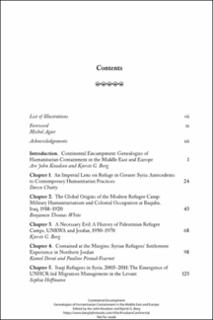| dc.description.abstract | Beginning in 2012, the civil war in Syria displaced millions within the country and as refugees to neighbouring states. Three years later, more than a million had reached Europe, before the EU and member states closed ranks to stop ‘irregular migration’. Could the many measures to contain refugees and migrants in the Middle East region be the contours of a new ‘hosting continent’, one having features known from the burgeoning literature on refugee camps? Having studied refugee camps and shelters in Lebanon for nearly two decades, I knew the vast scholarly research on camps, while Kjersti had spent years doing archival research on Palestinian refugee camps and UNRWA camp policies. Could, we hypothesized, refugee camps, as traditionally understood, be scaled up to embrace a region now hosting millions of refugees and migrants, many supported by new aid modalities and contained by border regimes that was now being instituted across the region and Europe’s borderlands?
To explore this hypothesis, both current configurations, and the antecedents of encampment policies and practices, we contacted colleagues that could help us explore refugee management and containment starting with the early displacement crises in the late Ottoman Empire (Dawn Chatty), and the first refugee camps under British Army control (Ben White). As the British and French Mandates gave way to nation states displacing minorities, the many camps for Palestinian refugees came to define the region’s new ‘encampment’ (Kjersti Berg). Moving into the present, Syria resisted the UNHCR’s call for establishing camps for Iraqi refugees (Sophia Hoffmann) but established a new aid paradigm that contained Syrians displaced as ‘urban refugees’ in cities and towns in Lebanon (Are John Knudsen) and Jordan (Kamel Doraï and Pauline Piraud-Fournet). Further afield, the re-bordering of Europe served to stop, turn back, and return migrants and ref | |
